Direct Utilization of Geothermal Energy
Abstract
:1. Introduction
2. Data Summary
| Country | Capacity (MWt) | Annual Use (TJ/yr) | Annual Use (GWh/yr) | Capacity Factor |
|---|---|---|---|---|
| Albania | 11.48 | 40.46 | 11.2 | 0.11 |
| Algeria | 66.84 | 2,098.68 | 583.0 | 1.00 |
| Argentina | 307.47 | 3,906.74 | 1,085.3 | 0.40 |
| Armenia | 1 | 15 | 4.2 | 0.48 |
| Australia | 33.33 | 235.1 | 65.3 | 0.22 |
| Austria | 662.85 | 3,727.7 | 1,035.6 | 0.18 |
| Belarus | 4.5 | 44.43 | 12.3 | 0.31 |
| Belgium | 117.9 | 546.97 | 151.9 | 0.15 |
| Bosnia & Herzegovina | 21.696 | 255.36 | 70.9 | 0.37 |
| Brazil | 360.1 | 6,622.4 | 1,839.7 | 0.58 |
| Bulgaria | 98.3 | 1,370.12 | 380.6 | 0.44 |
| Canada | 1126 | 8,873 | 2,464.9 | 0.25 |
| Caribbean Islands | 0.103 | 2.775 | 0.8 | 0.85 |
| Chile | 9.11 | 131.82 | 36.6 | 0.46 |
| China | 8,898 | 7,5348.3 | 20,931.8 | 0.27 |
| Columbia | 14.4 | 287 | 79.7 | 0.63 |
| Costa Rica | 1 | 21 | 5.8 | 0.67 |
| Croatia | 67.48 | 468.89 | 130.3 | 0.22 |
| Czech Republic | 216.5 | 1,290 | 358.4 | 0.19 |
| Denmark | 200 | 2,500 | 694.5 | 0.40 |
| Ecuador | 5.157 | 102.401 | 28.4 | 0.63 |
| Egypt | 1 | 15 | 4.2 | 0.48 |
| El Salvador | 2 | 40 | 11.1 | 0.63 |
| Estonia | 63 | 356 | 98.9 | 0.18 |
| Ethiopia | 2.2 | 41.6 | 11.6 | 0.60 |
| Finland | 994 | 7,966 | 2,213.0 | 0.25 |
| France | 1345 | 12,929 | 3591.7 | 0.30 |
| Georgia | 26.51 | 689.34 | 191.5 | 0.82 |
| Germany | 2,485.4 | 12,764.5 | 3,546.0 | 0.16 |
| Greece | 134.6 | 937.8 | 260.5 | 0.22 |
| Guatemala | 2.31 | 56.46 | 15.7 | 0.78 |
| Honduras | 1.933 | 45 | 12.5 | 0.74 |
| Hungary | 654.6 | 9767 | 2,713.3 | 0.47 |
| Iceland | 1,826 | 24,361 | 6,767.5 | 0.42 |
| India | 265 | 2,545 | 707.0 | 0.30 |
| Indonesia | 2.3 | 42.6 | 11.8 | 0.59 |
| Iran | 41.608 | 1,064.18 | 295.6 | 0.81 |
| Ireland | 134.45 | 691.91 | 192.2 | 0.16 |
| Israel | 82.4 | 2,193 | 609.2 | 0.84 |
| Italy | 867 | 9,941 | 2,761.6 | 0.36 |
| Japan | 2,099.53 | 25,697.94 | 7,138.9 | 0.39 |
| Jordan | 153.3 | 1,540 | 427.8 | 0.32 |
| Kenya | 16 | 126.624 | 35.2 | 0.25 |
| Korea (South) | 229.3 | 1,954.65 | 543.0 | 0.27 |
| Latvia | 1.63 | 31.81 | 8.8 | 0.62 |
| Lithuania | 47.6 | 411.52 | 114.3 | 0.27 |
| Macedonia | 47.18 | 601.41 | 167.1 | 0.40 |
| Mexico | 155.82 | 4,022.8 | 1,117.5 | 0.82 |
| Mongolia | 6.8 | 213.2 | 59.2 | 0.99 |
| Morocco | 5.02 | 79.14 | 22.0 | 0.50 |
| Nepal | 2.717 | 73.743 | 20.5 | 0.86 |
| Netherlands | 1,410.26 | 10,699.4 | 2,972.3 | 0.24 |
| New Zealand | 393.22 | 9,552 | 2,653.5 | 0.77 |
| Norway | 1,000 | 10,800 | 3,000.2 | 0.34 |
| Papua New Guinea | 0.1 | 1 | 0.3 | 0.32 |
| Peru | 2.4 | 49 | 13.6 | 0.65 |
| Philippines | 1.67 | 12.65 | 3.5 | 0.24 |
| Poland | 281.05 | 1,501.1 | 417.0 | 0.17 |
| Portugal | 28.1 | 386.4 | 107.3 | 0.44 |
| Romania | 153.24 | 1,265.43 | 351.5 | 0.26 |
| Russia | 308.2 | 6,143.5 | 1,706.7 | 0.63 |
| Serbia | 100.8 | 1,410 | 391.7 | 0.44 |
| Slovak Republic | 132.2 | 3,067.2 | 852.1 | 0.74 |
| Slovenia | 115.6 | 1,015.1 | 282.0 | 0.28 |
| South Africa | 6.01 | 114.75 | 31.9 | 0.61 |
| Spain | 141.04 | 684.05 | 190.0 | 0.15 |
| Sweden | 4,460 | 45,301 | 12,584.6 | 0.32 |
| Switzerland | 1,060.9 | 7,714.6 | 2,143.1 | 0.23 |
| Tajikistan | 2.93 | 55.4 | 15.4 | 0.60 |
| Thailand | 2.54 | 79.1 | 22.0 | 0.99 |
| Tunisia | 43.8 | 364 | 101.1 | 0.26 |
| Turkey | 2,084 | 36,885.9 | 10,246.9 | 0.56 |
| Ukraine | 10.9 | 118.8 | 33.0 | 0.35 |
| United Kingdom | 186.62 | 849.74 | 236.1 | 0.14 |
| United States | 12,611.46 | 56,551.8 | 15,710.1 | 0.14 |
| Venezuela | 0.7 | 14 | 3.9 | 0.63 |
| Vietnam | 31.2 | 92.33 | 25.6 | 0.09 |
| Yemen | 1 | 15 | 4.2 | 0.48 |
| Total | 48,493 | 423,830 | 117,740 | 0.28 |
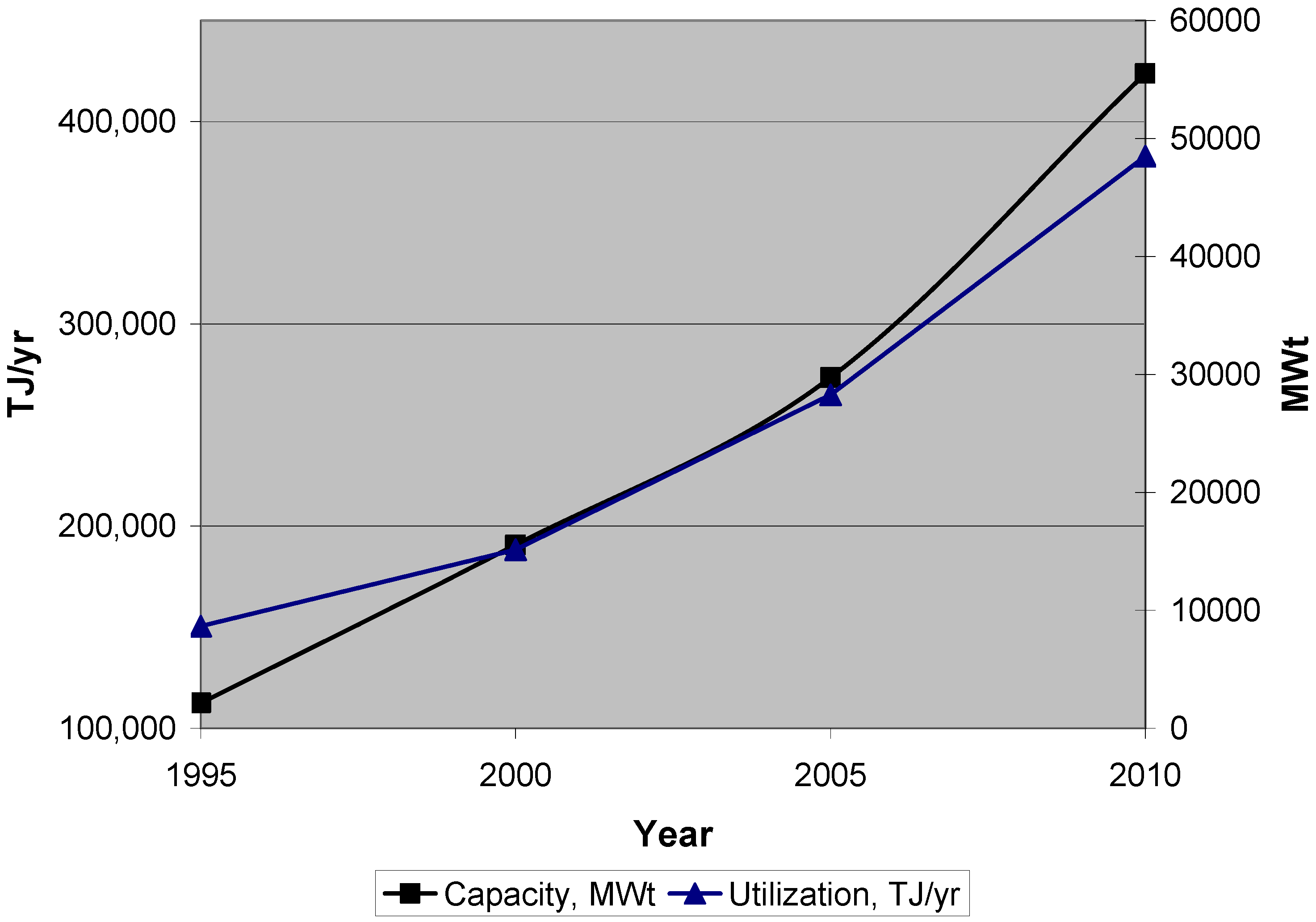
3. Categories of Utilization
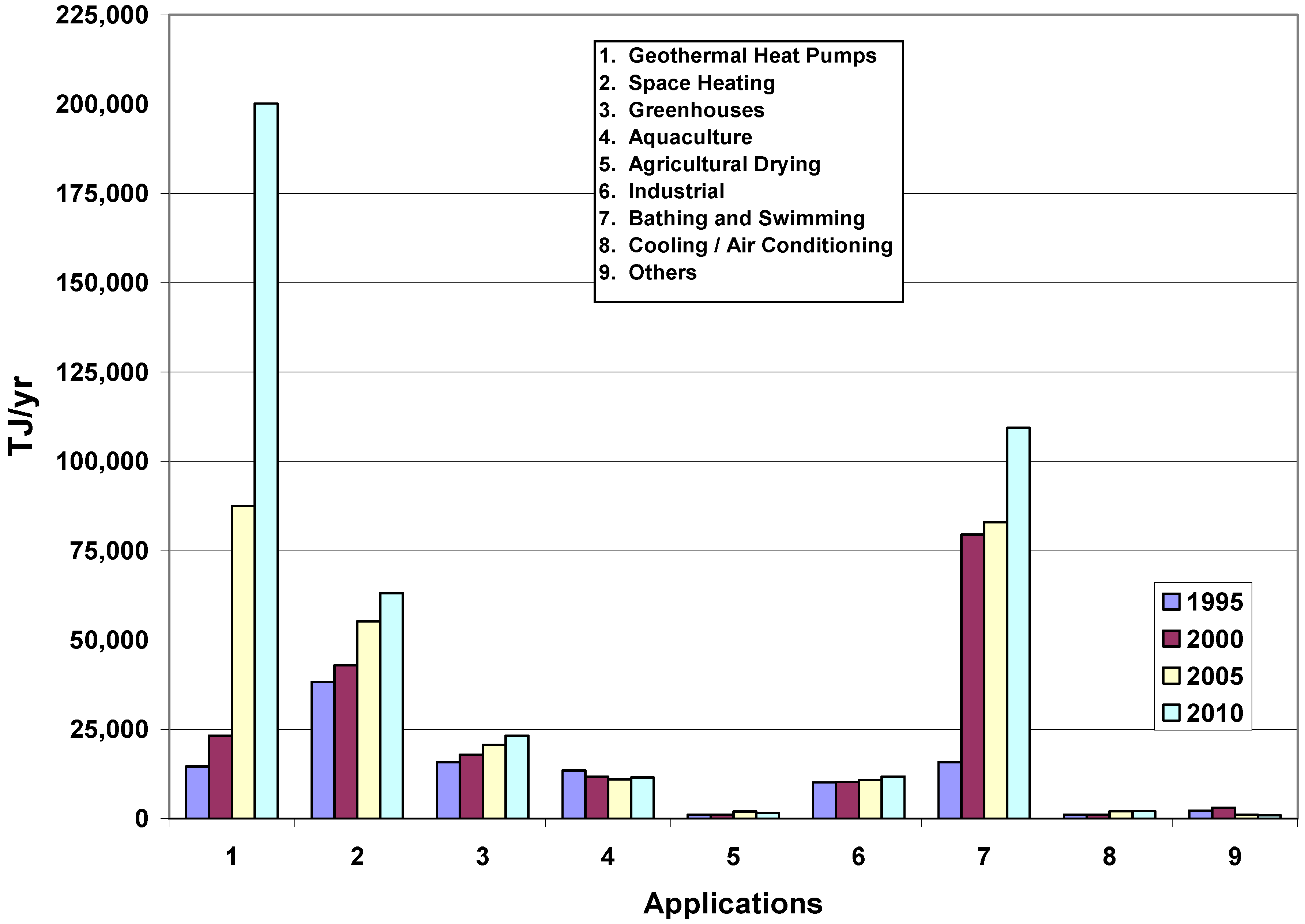
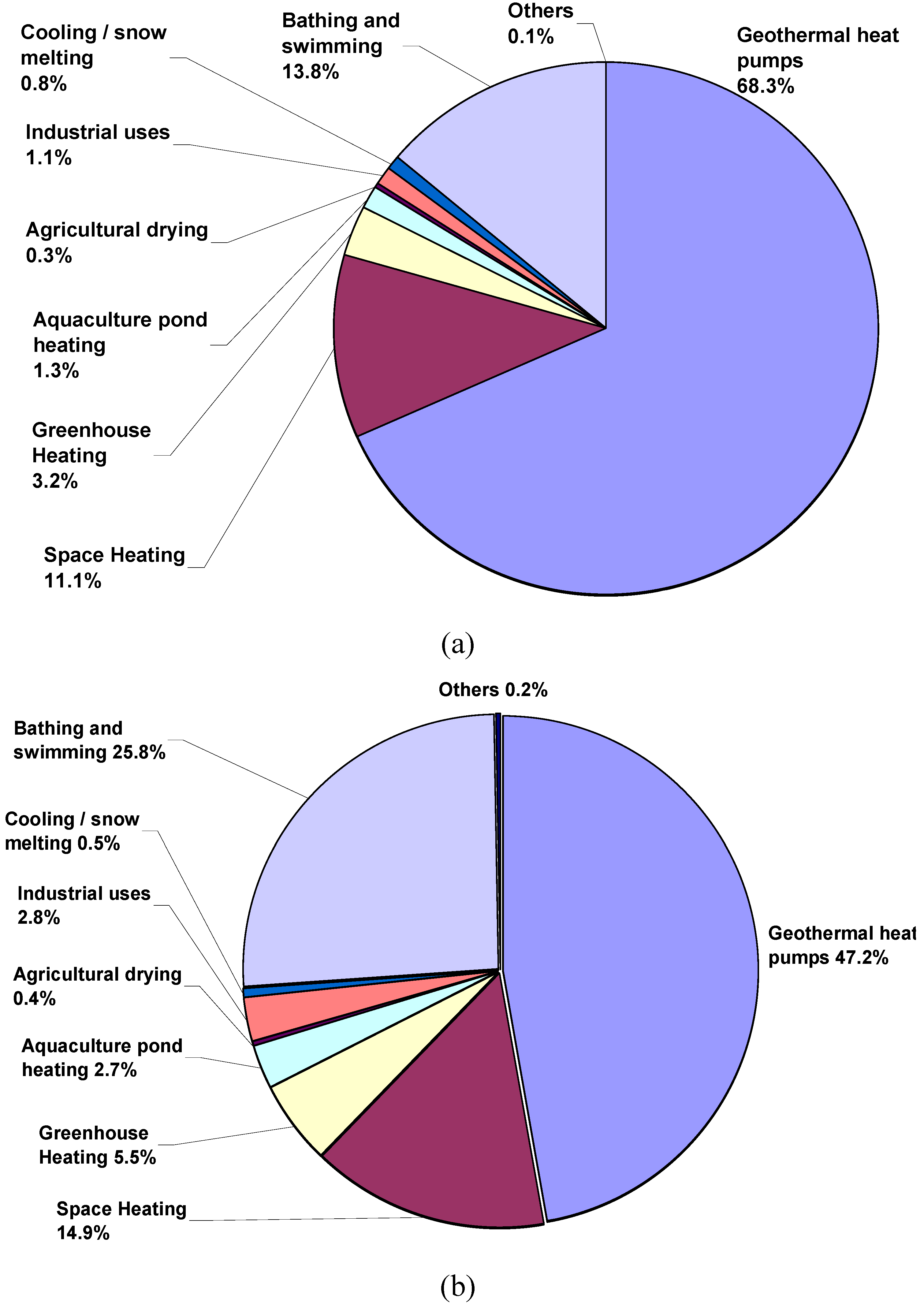
3.1. Geothermal Heat Pumps
| 2010 | 2005 | 2000 | 1995 | |
|---|---|---|---|---|
| Capacity (MWt) | ||||
| Geothermal Heat Pumps | 33,134 | 15,384 | 5,275 | 1,854 |
| Space Heating | 5,391 | 4,366 | 3,263 | 2,579 |
| Greenhouse Heating | 1,544 | 1,404 | 1,246 | 1,085 |
| Aquaculture Pond Heating | 653 | 616 | 605 | 1,097 |
| Agricultural Drying | 125 | 157 | 74 | 67 |
| Industrial Uses | 533 | 484 | 474 | 544 |
| Bathing and Swimming | 6,700 | 5,401 | 3,957 | 1,085 |
| Cooling / Snow Melting | 368 | 371 | 114 | 115 |
| Others | 42 | 86 | 137 | 238 |
| Total | 48,493 | 28,269 | 15,145 | 8,664 |
| Utilization (TJ/yr) | ||||
| Geothermal Heat Pumps | 200,149 | 87,503 | 23,275 | 14,617 |
| Space Heating | 63,025 | 55,256 | 42,926 | 38,230 |
| Greenhouse Heating | 23,264 | 20,661 | 17,864 | 15,742 |
| Aquaculture Pond Heating | 11,521 | 10,976 | 11,733 | 13,493 |
| Agricultural Drying | 1,635 | 2,013 | 1,038 | 1,124 |
| Industrial Uses | 11,745 | 10,868 | 10,220 | 10,120 |
| Bathing and Swimming | 109,410 | 83,018 | 79,546 | 15,742 |
| Cooling/Snow Melting | 2,126 | 2,032 | 1,063 | 1,124 |
| Others | 955 | 1,045 | 3,034 | 2,249 |
| Total | 423,830 | 273,372 | 190,699 | 112,441 |
| Capacity Factor | ||||
| Geothermal Heat Pumps | 0.19 | 0.18 | 0.14 | 0.25 |
| Space Heating | 0.37 | 0.40 | 0.42 | 0.47 |
| Greenhouse Heating | 0.48 | 0.47 | 0.45 | 0.46 |
| Aquaculture Pond Heating | 0.56 | 0.57 | 0.61 | 0.39 |
| Agricultural Drying | 0.41 | 0.41 | 0.44 | 0.53 |
| Industrial Uses | 0.70 | 0.71 | 0.68 | 0.59 |
| Bathing and Swimming | 0.52 | 0.49 | 0.64 | 0.46 |
| Cooling/Snow Melting | 0.18 | 0.18 | 0.30 | 0.31 |
| Others | 0.72 | 0.39 | 0.70 | 0.30 |
| Total | 0.28 | 0.31 | 0.40 | 0.41 |
3.2. Space Heating
3.3. Agribusiness Applications
3.3.1. Greenhouse and Covered Ground Heating
3.3.2. Aquaculture Pond and Raceway Heating
3.4. Industrial Applications & Agricultural Drying
3.4.1 Agricultural Crop Drying
3.4.2. Industrial Process Heat
3.5. Snow Melting and Space Cooling
3.6. Bathing and Swimming
3.7. Other Uses
4. Capacity Factors
5. Direct-Use Temperature Requirements
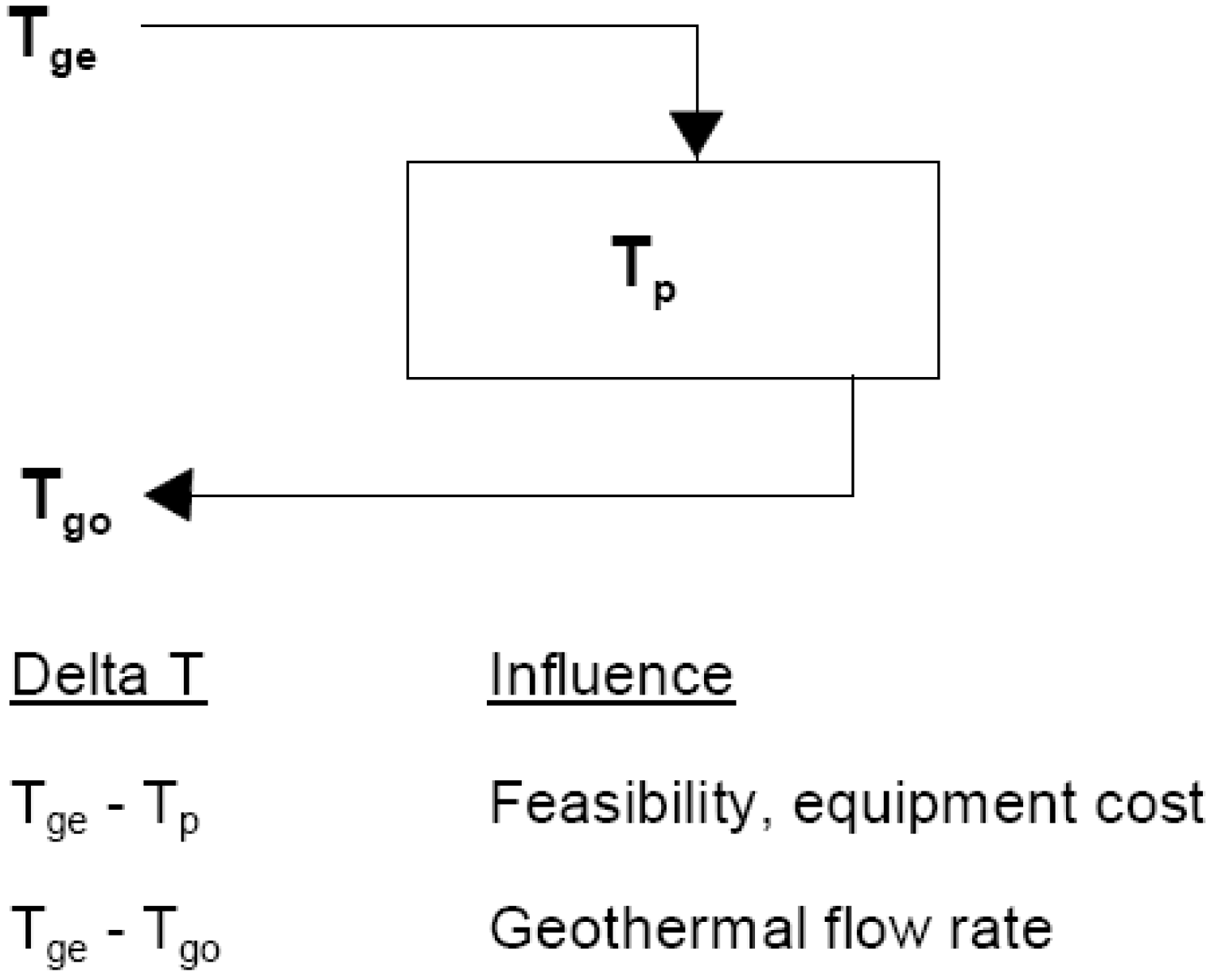
5.1. Pool and Aquaculture Pond Heating

5.2. Greenhouse and Building Space Heating


“All of the rules of thumb discussed here are exactly that. It is possible in all cases to “bend the rules,” and design systems and equipment for temperatures closer than the guidelines provided above. The values provided here are intended for initial evaluation of applications by those not in the practice of designing heating systems on a regular basis. The guidelines cited apply to new systems using commercially manufactured equipment. Homemade heat exchangers or existing equipment selected for water temperatures well above available geothermal temperature would require additional analysis.
6. Equipment
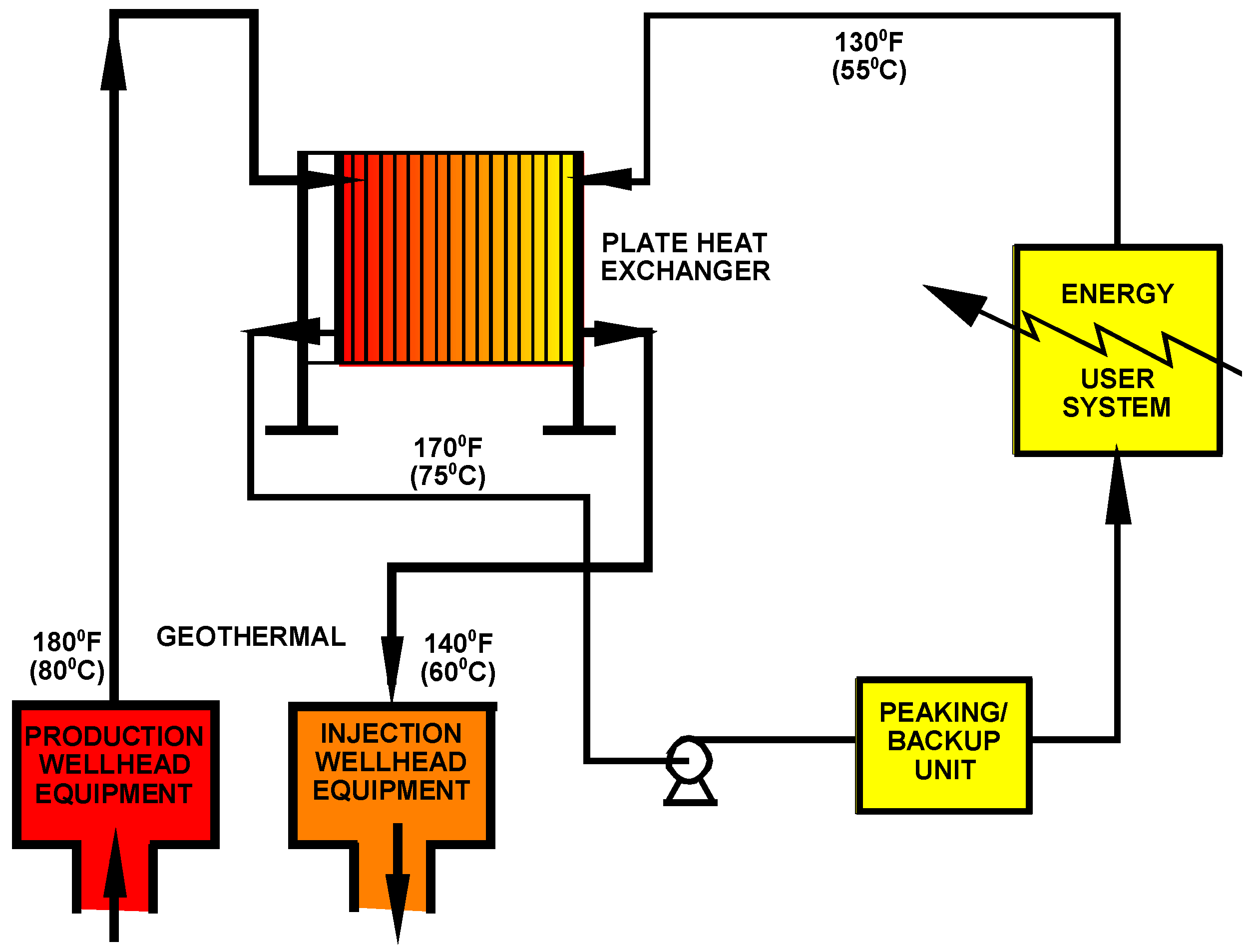
6.1. Downhole Pumps
6.2. Piping
6.3. Heat Exchangers
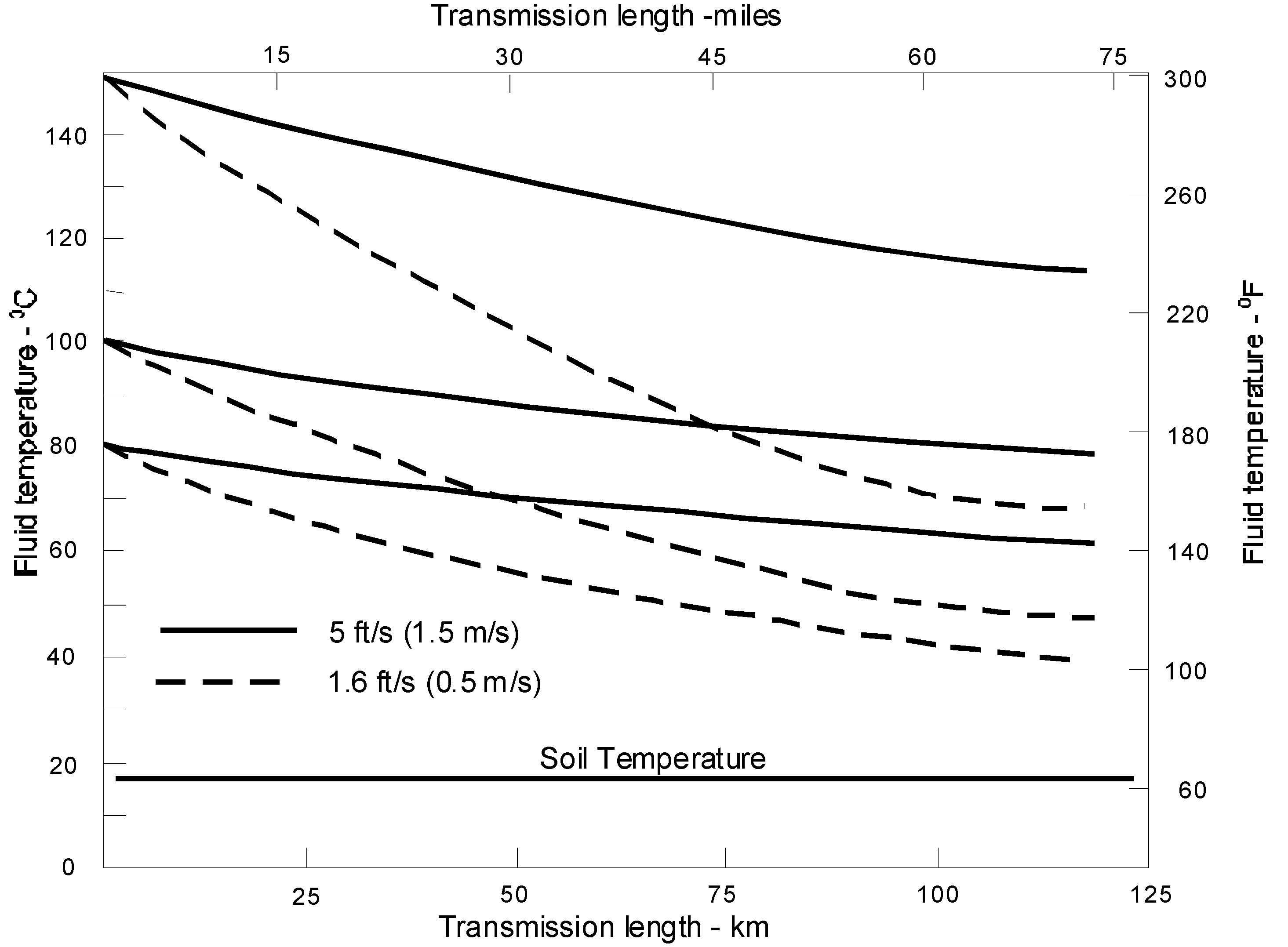
6.4. Heat Pumps
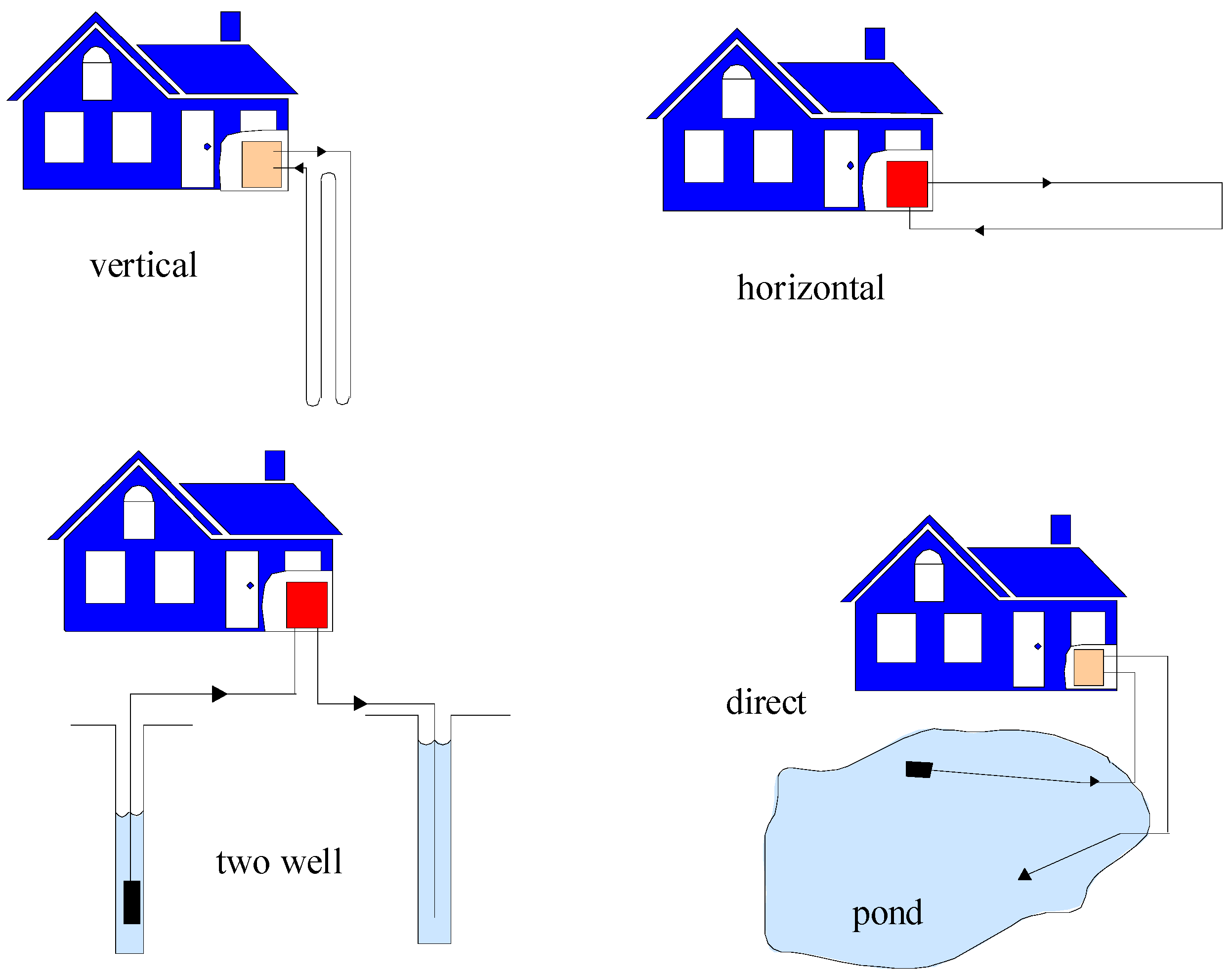
6.5. Convectors
6.6. Refrigeration
7. Economic Considerations
| Application | Capital Cost | O&M | Total | |
|---|---|---|---|---|
| $/kW | $/kWyr | $/kWyr | $/kWyr | |
| Residential Space Heat* | 800 | 71.1 | 7.1 | 78.2 |
| Comm/Inst. Space Heat* | 500 | 44.4 | 4.4 | 48.4 |
| District Heating | 650 | 57.7 | 5.8 | 63.5 |
| Greenhouse Heating | 250 | 22.2 | 2.2 | 24.4 |
| Aquaculture Pond Heat | 200 | 17.8 | 1.8 | 19.6 |
| Geothermal HP** | 850 | 75.5 | 7.6 | 83.1 |
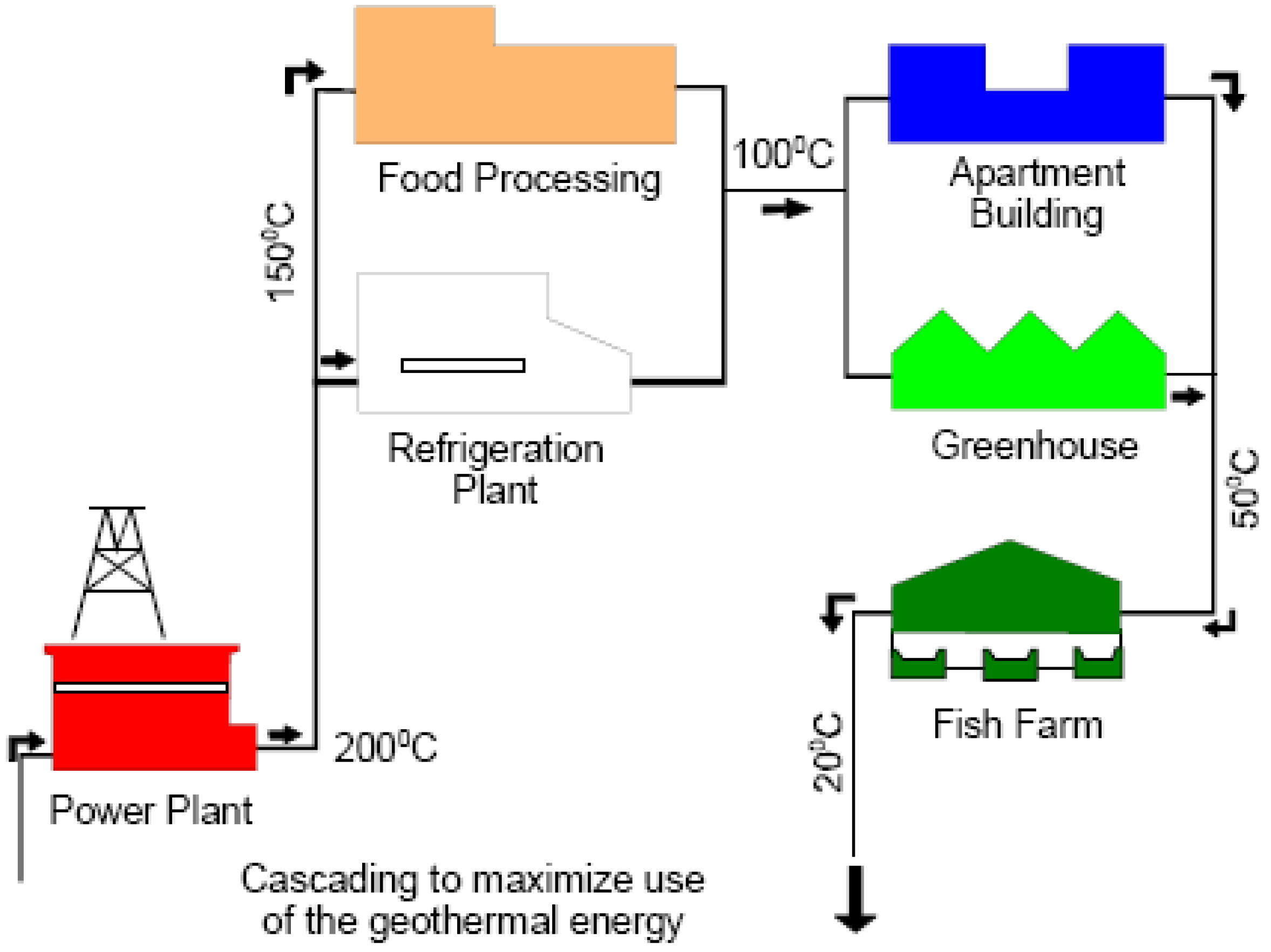
8. Energy Savings
| Fuel Oil | Carbon | CO2 | SOx | NOx | ||
| bbl | TOE | TOE | TOE | TOE | TOE | |
| As Electricity Electricity | 250.0 | 37.5 | 33.2 | 1o6.9 | 0.74 | 0.022 |
| As Direct Heat | 125.0 | 18.8 | 16.6 | 53.4 | 0.37 | 0.011 |
9. Concluding Remarks
References
- Lund, J.W.; Freeston, H.H.; Boyd, T.L. Direct Utilization of Geothermal Energy 2010 Worldwide Review. In Proceedings of World Geothermal Congress 2010, Bali, Indonesia, 26–30 April 2010. No. 0007.
- Dickson, M.H.; Fanelli, M. Geothermal Energy: Utilization and Technology; UNESCO Renewable Energy Series: Paris, France, 2003; p. 205. [Google Scholar]
- Cataldi, R.; Hodgson, S.F.; Lund, J.W. Stories from a Heated Earth–Our Geothermal Heritage; Geothermal Resources Council and International Geothermal Association: Davis, CA, USA, 1999; p. 569. [Google Scholar]
- Gudmundsson, J.S.; Lund, J.W. Direct Uses of Earth Heat. Int. J. Energy Res. 1985, 9, 345–375. [Google Scholar] [CrossRef]
- Lund, J.W. Geothermal Direct-Use Equipment Overview. In Geo-Heat Center Quarterly Bulletin; Geo-Heat Center, Oregon Institute of Technology: Klamath Falls, OR, USA, 1998; pp. 1–6. [Google Scholar]
- Ragnarsson, A. Geothermal Development in Iceland 2005-2009. In Proceedings of World Geothermal Congress 2010, Bali, Indonesia; 2010. No. 0124. [Google Scholar]
- Curtis, R.; Lund, J.; Sanner, B.; Rybach, L.; Hellström, G. Ground Source Heat Pumps—Geothermal Energy for Anyone, Anywhere: Current Worldwide Activity. In Proceedings of World Geothermal Congress 2005, Antalya, Turkey, 24–29 April 2005. No. 1437.
- Boyd, T.L. The Oregon Institute of Technology Geothermal Heating System—Then and Now. In Geo-Heat Center Quarterly Bulletin; Geo-Heat Center, Oregon Institute of Technology: Klamath Falls, OR, USA, 1999; pp. 10–13. [Google Scholar]
- Lund, J.W.; Boyd, T. Oregon Institute of Technology Geothermal Uses and Projects, Past, Present and Future. In Proceedings of Thirty-Fourth Workshop on Geothermal Reservoir Engineering, Stanford University, Stanford, CA, USA, 9–11 February 2009. (CD ROM).
- Bloomquist, R.G.; Nimmons, J.T.; Rafferty, K. District Heating Development Guide; Washington State Energy Office: Olympia, DC, USA, 1987; Volume 1. [Google Scholar]
- Lund, J.W.; Klein, R. Prawn Park—Taupo, New Zealand. In Geo-Heat Center Quarterly Bulletin; Geo-Heat Center, Oregon Institute of Technology: Klamath Falls, OR, USA, 1995; pp. 27–29. [Google Scholar]
- Bloomer, A. Kawerau Geothermal Development: A Case Study. In Geo-Heat Center Quarterly Bulletin; Geo-Heat Center, Oregon Institute of Technology: Klamath Falls, OR, USA, 1998; pp. 15–18. [Google Scholar]
- Lund, J.W. Onion Dehydration. In Transaction; Geothermal Resources Council: Davis, CA, USA, 1995; pp. 69–74. [Google Scholar]
- Chiasson, A. Geothermal Energy Utilization in Ethanol Production. In Geo-Heat Center Quarterly Bulletin; Geo-Heat Center, Oregon Institute of Technology: Klamath Falls, OR, USA, 2007; pp. 2–5. [Google Scholar]
- Trexler, D.T.; Flynn, T.; Hendrix, J.W. Heap Leaching. In Geo-Heat Center Quarterly Bulletin; Geo-Heat Center, Oregon Institute of Technology: Klamath Falls, OR, USA, 1990; pp. 1–4. [Google Scholar]
- Lund, J.W.; Rangel, M.A. Pilot Fruit Drier for the Los Azufres Geothermal Field, Mexico. In Processing of The World Geothermal Congress, Florence, Italy, 18–31 May 1995; 1995; pp. 2335–2338. [Google Scholar]
- Andritsos, N.; Dalampakis, P.; Kolios, N. Use of Geothermal Energy for Tomato Drying. In Geo-Heat Center Quarterly Bulletin; Geo-Heat Center, Oregon Institute of Technology: Klamath Falls, OR, USA, 2003; pp. 9–13. [Google Scholar]
- Lund, J.W.; Lienau, P.J. Onion Dehydration. In Geo-Heat Center Quarterly Bulletin; Geo-Heat Center, Oregon Institute of Technology: Klamath Falls, OR, USA, 1994; pp. 15–18. [Google Scholar]
- Lund, J.W.; Boyd, T. Geothermal Uses and Projects on the Oregon Institute of Technology Campus. In Geo-Heat Center Quarterly Bulletin; Geo-Heat Center, Oregon Institute of Technology: Klamath Falls, OR, USA, 2010; pp. 12–17. [Google Scholar]
- Lund, J.W. Balneological Use of Thermal and Mineral Waters in the USA. In Geothermics; Elsevier: Amsterdam, Netherlands, 1996; pp. 103–148. [Google Scholar]
- Taguchi, S.; Itoi, R.; Ysa, Y. Beppu Hot Springs. In Geo-Heat Center Quarterly Bulletin; Geo-Heat Center, Oregon Institute of Technology: Klamath Falls, OR, USA, 1996; pp. 1–6. [Google Scholar]
- Lund, J.W. Geothermal Spas in Czechoslovakia. In Geo-Heat Center Quarterly Bulletin; Geo-Heat Center, Oregon Institute of Technology: Klamath Falls, OR, USA, 1990; pp. 20–24. [Google Scholar]
- Lund, J.W.; Freeston, D.H. World-Wide Direct Uses of Geothermal Energy 2000. In Geothermic; Elsevier: London, UK, 2001; pp. 29–68. [Google Scholar]
- Lund, J.W.; Freeston, D.H.; Boyd, T.L. Direct Application of Geothermal Energy: 2005 Worldwide Review. In Geothermics; Elsevier: Amsterdam. Netherlands, 2005; pp. 691–727. [Google Scholar]
- Rafferty, K. Direct-Use Temperature Requirements: A Few Rules of Thumb. In Geo-Heat Center Quarterly Bulletin; Geo-Heat Center, Oregon Institute of Technology: Klamath Falls, OR, USA, 2004; pp. 1–3. [Google Scholar]
- Lund, J.W.; Lienau, P.J.; Lunis, B.C. Geothermal Direct-Use Engineering and Design Guidebook; Geo-Heat Center: Klamath Falls, OR, USA, 1998; p. 470. [Google Scholar]
- Rafferty, K.; Keiffer, S. Thermal Expansion in Enclosed Lineshaft Pump Columns. In Geo-Heat Center Quarterly Bulletin; Geo-Heat Center, Oregon Institute of Technology: Klamath Falls, OR, USA, 2002; pp. 11–15. [Google Scholar]
- Ragnarsson, A.; Hrolfsson, I. Akranes and Borgarfjordur District Heating System. In Geo-Heat Center Quarterly Bulletin; Geo-Heat Center, Oregon Institute of Technology: Klamath Falls, OR, 1998; pp. 10–13. [Google Scholar]
- Hitaveita Reykjavikur and the Nesjavellir Geothermal Co-Generation Plant. In Geo-Heat Center Quarterly Bulletin; Lund, J.W. (Ed.) Geo-Heat Center, Oregon Institute of Technology: Klamath Falls, OR, 2005; pp. 19–24.
- Culver, G.G.; Reistad, G.M. Evaluation and Design of Downhole Heat Exchangers for Direct Applications; Geo-Heat Center: Klamath Falls, OR, USA, 1978; p. 16. [Google Scholar]
- Downhole Heat Exchangers. In Geo-Heat Center Quarterly Bulletin; Geo-Heat Center: Klamath Falls, OR, USA, 1999; p. 28.
- Dunstall, M.G.; Freeston, D.H. Downhole Heat Exchanger Performance in a 4-inch Well, Rotorua, New Zealand. In Proceedings of 12th New Zealand Geothermal Workshop; Auckland, New Zealand, 1990; pp. 229–232. [Google Scholar]
- Kavanaugh, S.; Rafferty, K. Ground-Source Heat Pumps: Design of Geothermal Systems for Commercial and Institutional Buildings; ASHRAE: Atlanta, GA, USA, 1997; p. 167. [Google Scholar]
- Jessop, A.M.; MacDonald, J.K.; Spence, H. Clean Energy from Abandoned Mines at Springhill, Nova Scotia. Energy Sources 1995, 17, 93–106. [Google Scholar] [CrossRef]
- Malolepszy, Z.; Demollin, E.; Bowers, D. Potential Use of Geothermal Energy from Mine Water in Europe for Cooling and Heating. In Procceedings of International Conference Passive and Low Energy Cooling for the Built Environment, Santorini Island, Greece, 19–21 May 2005.
- Florides, G.; Kalogirou, S. Ground Heat Exchangers—A Reivew of Systems, Models and Applicatons. In Renewable Energy; Elsevier: Amsterdam, Netherlands, 2007; pp. 2461–2478. [Google Scholar]
- Omer, A.M. Ground-Source Heat Pumps Systems and Applications. In Renewable and Sustainable Energy Reviews; Elsevier: Amsterdam, Netherlands, 2008; pp. 344–371. [Google Scholar]
- Rafferty, K. Absorption Refrigeration: Cooling with Hot Water. In Geo-Heat Center Quarterly Bulletin; Geo-Heat Center, Oregon Institute of Technology: Klamath Falls, OR, USA, 1983; pp. 17–20. [Google Scholar]
- Combined Heat & Power Plant. In Geo-Heat Center Quarterly Bulletin; Geo-Heat Center, Oregon Institute of Technology: Klamath Falls, OR, USA, 2005; p. 36.
- Kasameyer, R. Brief Guidelines for the Development of Inputs to CCTS from the Technology Working Group; Working Draft; Lawrence Livermore Laboratory: Livermore, CA, USA, 1997. [Google Scholar]
- Goddard, W.B.; Goddard, C.B. Energy Fuel Sources and Their Contribution to Recent Global Air Pollution Trends. In Transactions; Geothermal Resources Council: Davis, CA, USA, 1990; pp. 643–649. [Google Scholar]
© 2010 by the authors; licensee MDPI, Basel, Switzerland. This article is an Open Access article distributed under the terms and conditions of the Creative Commons Attribution license (http://creativecommons.org/licenses/by/3.0/).
Share and Cite
Lund, J.W. Direct Utilization of Geothermal Energy. Energies 2010, 3, 1443-1471. https://doi.org/10.3390/en3081443
Lund JW. Direct Utilization of Geothermal Energy. Energies. 2010; 3(8):1443-1471. https://doi.org/10.3390/en3081443
Chicago/Turabian StyleLund, John W. 2010. "Direct Utilization of Geothermal Energy" Energies 3, no. 8: 1443-1471. https://doi.org/10.3390/en3081443
APA StyleLund, J. W. (2010). Direct Utilization of Geothermal Energy. Energies, 3(8), 1443-1471. https://doi.org/10.3390/en3081443




